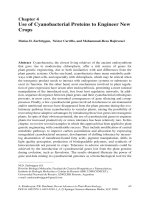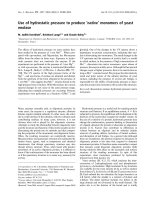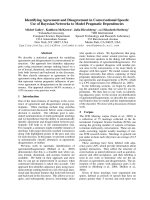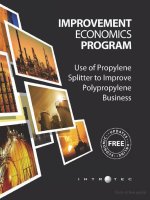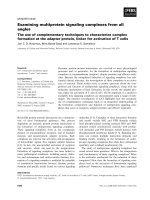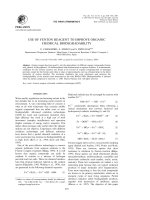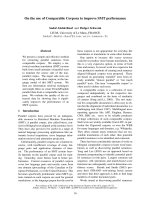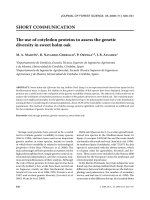Use of Cyanobacterial Proteins to Engineer New Crops
Bạn đang xem bản rút gọn của tài liệu. Xem và tải ngay bản đầy đủ của tài liệu tại đây (206.26 KB, 6 trang )
Chapter 4
Use of Cyanobacterial Proteins to Engineer New
Crops
Matias D. Zurbriggen, Néstor Carrillo, and Mohammad-Reza Hajirezaei
Abstract Cyanobacteria, the closest living relatives of the ancient endosymbiont
that gave rise to modern-day chloroplasts, offer a rich source of genes for
plant genetic engineering, due to both similarities with and differences from the
plant genetic systems. On the one hand, cyanobacteria share many metabolic path-
ways with plant cells, and especially with chloroplasts, which may be critical when
the transgenic product needs to interact with endogenous systems or substrates to
exert its function. On the other hand, most mechanisms involved in plant regula-
tion of gene expression have arisen after endosymbiosis, permitting a more rational
manipulation of the introduced trait, free from host regulatory networks. In addi-
tion, sequence divergence between plant genes and their cyanobacterial orthologues
prevents, in most cases, the unwanted consequences of gene silencing and cosup-
pression. Finally, a few cyanobacterial genes involved in tolerance to environmental
and/or nutritional stresses have disappeared from the plant genome during the evo-
lutionary pathway from cyanobacteria to vascular plants, raising the possibility of
recovering these adaptive advantages by introducing those lost genes into transgenic
plants. In spite of their obvious potential, the use of cyanobacterial genes to engineer
plants for increased productivity or stress tolerance has been relatively rare. In this
chapter, we review several examples in which this approach has been applied to plant
genetic engineering with considerable success. They include modification of central
metabolic pathways to improve carbon assimilation and allocation by expressing
unregulated cyanobacterial enzymes, development of chilling tolerance by increas-
ing desaturation of membrane-bound fatty acids, pigment manipulation, shifts in
light quality perception, production of biodegradable polymers, and synthesis of
ketocarotenoids not present in crops. Tolerance to adverse environments could be
achieved by the introduction of cyanobacterial genes lost from the plant genome
during evolution, such as flavodoxin. The results obtained illustrate the power of
gene and data mining in cyanobacterial genomes as a biotechnological tool for the
M.D. Zurbriggen (
B
)
División Biología Molecular, Facultad de Ciencias Bioquímicas y Farmacéuticas,
Instituto de Biología Molecular y Celular de Rosario (IBR, UNR/CONICET),
Universidad Nacional de Rosario, S2002LRK Rosario, Argentina
e-mail:
65
A. Kirakosyan, P.B. Kaufman, Recent Advances in Plant Biotechnology,
DOI 10.1007/978-1-4419-0194-1_4,
C
Springer Science+Business Media, LLC 2009
66 M.D. Zurbriggen et al.
design of transgenic plants with higher productivity, enhanced tolerance to environ-
mental stress, and potential for biofarming.
4.1 Introduction
Development of crops with higher productivity, nutritional value, or potential for
biofarming is a major goal of plant biotechnology. Direct transfer of plant genes
has resulted in new varieties with improved properties. However, this approach is
limited by the genetic stock of extant plant species. Therefore, the use of bacterial
genes to engineer crop and model plants has become commonplace, with expres-
sion of the Bt toxin of Bacillus thuringiensis (milky spore bacterium) being the
most conspicuous case of worldwide application to agriculture (for a recent review,
see Jube and Borthakur, 2007). There are also limitations to the use of heterolo-
gous genes in transgenic plants, with important implications for the effectiveness of
the desired manipulation. Several factors play a role in the success of this strategy,
including the expression level of the transgene in the alien environment, successful
interaction with suitable endogenous partners, availability of substrate if the trans-
gene product is an enzyme, compartmentalization, and codon usage. In this sense,
cyanobacteria offer special opportunities for crop improvement due to both impor-
tant similarities with and differences from the plant genetic system. With respect to
the former aspect, it is worth noting that many plant metabolic, regulatory, and dissi-
pative pathways, especially those concerning chloroplast physiology, were evolved
from cyanobacterial ancestors “enslaved” after the successful endosymbiosis that
gave origin to photosynthetic eukaryotes. Many of these routes have not diverged
much, thus allowing productive interactions of the transgenic products with the cor-
responding endogenous systems. At the same time, an unknown number of regu-
latory networks that complicate handling of transgene expression are newcomers
in plant development and are not present in cyanobacteria, permitting a more cus-
tomized manipulation of the engineered traits. The sequence divergence between
plant proteins and their cyanobacterial counterparts also prevents in most cases the
undesired consequences of gene silencing and cosuppression. Finally, a few genes
of cyanobacterial origin have disappeared from the plant genome or have been pro-
foundly modified. Their introduction into plants opens unpredictable possibilities to
regain some of the adaptive advantages that allowed cyanobacteria to flourish and
spread at the beginning of aerobic times on Earth.
The upcoming challenge for the scientists is to use specific genes from various
sources to achieve a broad tolerance of plants to rapidly changing environmental
conditions. In general, the final goal is to develop plants with higher yields or tol-
erant to unfavorable stress situations. It is also an important aim to generate plants
with high-quality food properties or capable of producing renewable products (bio-
farming) (Fig. 4.1). Despite the many potential advantages of cyanobacterial genes,
their use has still been relatively limited. We review herein the various existing
4 Use of Cyanobacterial Proteins 67
Fig. 4.1 Summary of current advances in plant biotechnology using cyanobacterial genes. Gene
mining on cyanobacteria offers a promising opportunity as a tool for biotechnological approaches
examples, highlighting the cases in which their employment was particularly suc-
cessful (Table 4.1).
4.2 Manipulation of CO
2
Fixation and Sugar Metabolism
Photosynthetic carbon metabolism is believed to be one major determinant for plant
growth and final yield. To date, huge efforts have been made to use endogenous
genes in order to modify photosynthetic carbon assimilation and partitioning with
the aim to improve plant productivity (Morandini and Salamini, 2003; Geigen-
berger et al., 2004; Long et al., 2006). In most cases, these studies failed to provide
evidence for improvement of plant biomass production, since endogenous genes
derived from higher plants are likely to be prone to fine regulation in vivo.Inthis
connection, the main reasons could be found in the modulation of enzyme activity
by allosteric effects and covalent modification such as phosphorylation, or via inter-
mediates and effectors such as glucose 6-phosphate (G6P) (Krause et al., 1998),
suggesting that the use of cyanobacterial enzymes with different regulatory mech-
anisms could be a promising alternative. Attempts that have been made to manip-
ulate photoassimilate production, sucrose metabolism, and sugar utilization will be
discussed.
68 M.D. Zurbriggen et al.
Table 4.1 A summary of recent publications related to the use of cyanobacterial proteins in plants to improve growth properties
Protein Donor organism Engineered plant Pathway/function Improvement/advantage References
FBP/SBPase Synechococcus
PCC 7942
Nicotiana tabacum,
Chloroplast-targeted
Carbon assimilation
(Section 4.2.1)
(Calvin cycle)
Avoidance of endogenous
regulation Bifunctional
enzyme Increased
photosynthetic capacity
Miyagawa et al.
(2001)
ictB
Synechococcus
PCC 7942
Arabidopsis thaliana
Nicotiana tabacum
Carbon assimilation
(Section 4.2.1)
(Calvin cycle)
Increased photosynthetic
capacity and growth
Lieman-Hurwitz
et al. (2003)
SPS Synechocystis
PCC6803
Nicotiana tabacum,
Solanum lycopersicum,
Oryza sativa
Sucrose metabolism
(Section 4.2.2)
(Sucrose synthesis)
Avoidance of endogenous
regulation Increased sucrose
synthesis
Curatti et al. (1998)
PEPC Corynebacterium
glutamicum
Synechococcus
vulcanus
Vicia narbonensis
Arabidopsis thaliana
Sugar utilization
(Section 4.2.3)
(aminoacid
biosynthesis)
Avoidance of endogenous
regulation Increased protein
content
Rolletschek et al.
(2004)
Chen et al. (2002)
9
-desaturase Anacystis nidulans Nicotiana tabacum
Chloroplast-Targeted
Lipid desaturation
(Section 4.3)
Novel desaturase. Cold
tolerance
Ishizaki-Nishizawa
et al. (1996)
Acyl-lipid
9
-desaturase
Synechococcus
vulcanus
Nicotiana tabacum Lipid desaturation
(Section 4.3)
Cold tolerance Orlova et al. (2003)
6
-desaturase Synechocystis Nicotiana tabacum Lipid desaturation
(Section 4.3)
(γ-linolenic acid
synthesis)
Polyunsaturated fatty acid
synthesis
Reddy and Thomas
(1996)
4 Use of Cyanobacterial Proteins 69
Table 4.1 (continued)
Protein Donor organism Engineered plant Pathway/function Improvement/advantage References
CAO Prochlorothrix
hollandica
Arabidopsis thaliana Pigment manipulation
(Section 4.4)
Avoidance of endogenous
regulation
Change in pigment
composition
Hirashima et al.
(2006)
β-Carotene
ketolase
Synechocystis Solanum tuberosum,
Nicotiana glauca
Pigment manipulation
(Section 4.4)
(ketocarotenoid
synthesis)
Novel compounds
(astaxanthin)
Gerjets and
Sandmann (2006)
Zhu et al. (2007)
Cyanophycin
synthetase
Thermosynechococcus
elongatus
Nicotiana tabacum,
Solanum
tuberosum (cytosol),
Nicotiana tabacum
(chloroplasts)
Production of
biodegradable
polymers
(Section 4.5)
Biofarming. Production of
cyanophycin
Neumann et al.
(2005)
Hühns et al.
(2008)
Fd-PCB
reductase
Synechocystis
PCC6803
Arabidopsis thaliana Phytochrome perception
(Section 4.6)
(synthesis of PCB)
Shift in phytochrome
reaction spectra
Kami et al. (2004)
Fld Anabaena PCC7119 Nicotiana tabacum Electron transport
(Section 4.7)
Multiple stress tolerance Tognetti et al.
(2006, 2007)
Zurbriggen et al.
(2008)
Cyt c
6
Porphyra yezoensis Arabidopsis thaliana Electron transport
(Section 4.8)
Improved metabolism Chida et al. (2007)
DnaE intein Synechocystis
PCC6803
Arabidopsis thaliana
(cytosol and
chloroplasts)
Protein splicing
(Section 4.8)
Novel biotechnological
tool
Yang et al. (2003)
Chin et al. (2003)
